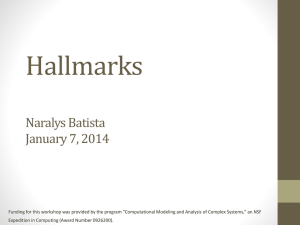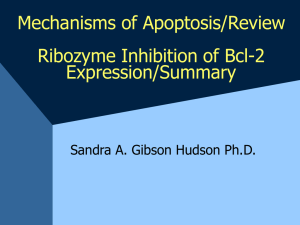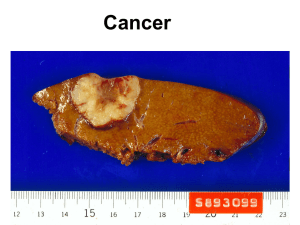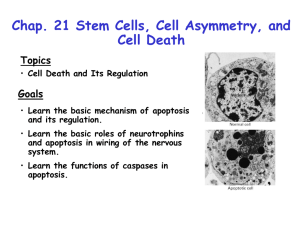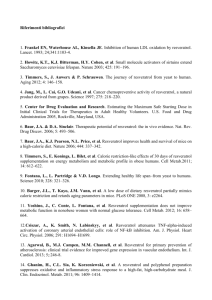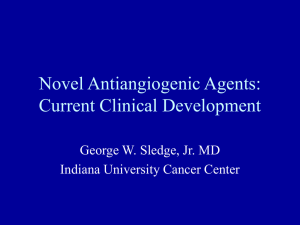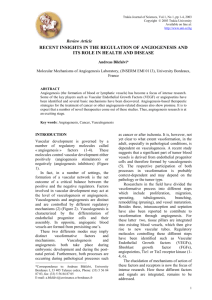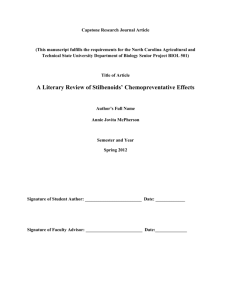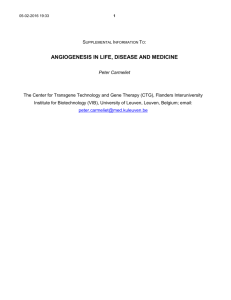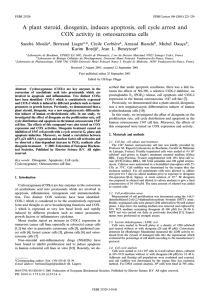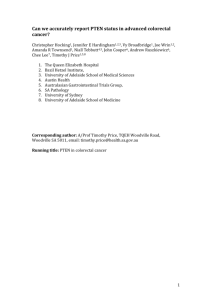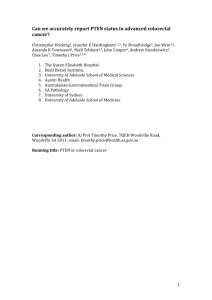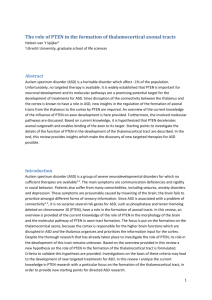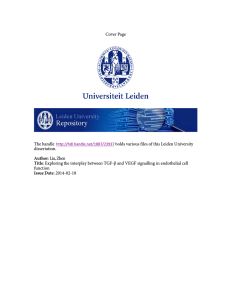treatment-planning-for-cancer
advertisement
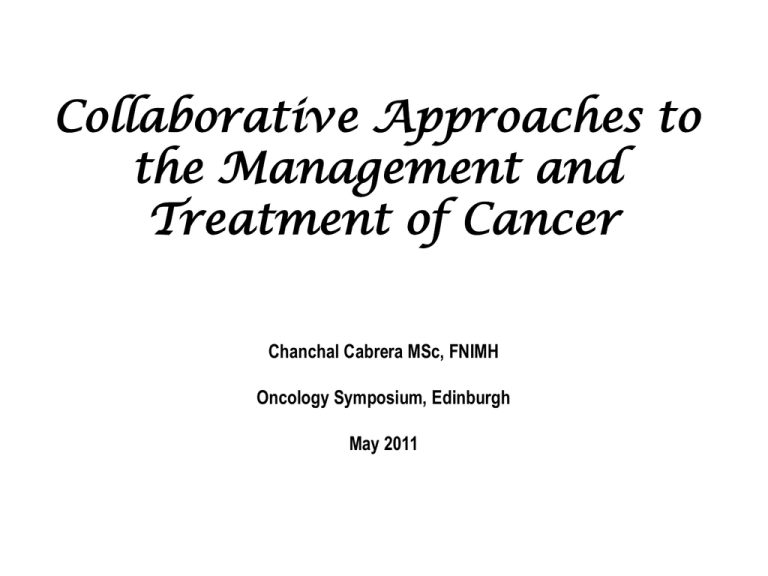
Collaborative Approaches to the Management and Treatment of Cancer Chanchal Cabrera MSc, FNIMH Oncology Symposium, Edinburgh May 2011 clinical case management in cancer care practical strategies and clinical pearls • decoding the diagnosis - what do the tests mean and how to interpret that information in a clinical application • designing a targeted treatment plan - specific strategies to address identified risks • materia medica for cancer - the cyto-toxic herbs • managing surgery, chemo and radiation - maximizing efficacy and mitigating harm Carcinogen exposure Unknown other factors Inherited genetic factors DNA deletion, mutation or methylation Alterations in RNA and protein expression / processing Inactivation of tumor suppressor genes David P. Carbone, MD, PhD Activation of oncogenes Failure of DNA repair Cancer Angiogenesis, invasion, metastasis Energetic Relationships endogenous Energetics of the Human Being (Spirit - Mind - Body) assess and target constitutional and energetic systems Energetics of the surrounding Environment assess and target the external environmental contributing factors exogenous Energetics of the Cancer assess and target the cancer’s characteristics endogenous /exogenous The Human Energy within An endogenous component comprising the personal energetic processes or the core constitution of the individual patient (spirit, mind, and body) and evaluated from a highly individualized perspective. The External Energy around An exogenous component comprising the external environment in which the patient lives and operates, his/her perceptions of it and its influences upon him/her, both psychic and physical. The Cancer Energy A mixed endogenous / exogenous component comprising the energetic and physiological processes of the cancer itself which both responds to and alters the environment. A comprehensive protocol will address: 1) Vital Essence, Vital Spirit and Vital Force: energy, adaptation, protection 2) The individual energetic and constitutional profile 3) Symptoms and the specific conventional therapies Nutrition and diet Botanical medicine Exercize Gardening Nature Music Prayer and Art meditation PATIENT (Spirit - Mind - Body) HOLISTIC PRACTITIONER Traditional / holistic healing techniques Intellect ONCOLOGIST Common sense Conventional medicine CANCER PHYSIOLOGY Initiation • Stress and worry • Genetics and oncogenes • Toxins and pollution (including drugs, diet, tobacco) • Radiation (medical, UV) Initiation • Viruses (Burkitts & Hodgkins lymphomas, nasopharyngeal carcinoma from EBV, cervical cancer from HPV, Kaposi’s sarcoma from HIV, Hepatocellular carcinoma from hepatitis B or C, Lymphoma from T cell lymphotrophic virus-1) • Hormones (estrogen, progesterone, testosterone, growth hormone, prolactin) • Oxidative stress All can trigger gene transcription instability and DNA mutations formation of aberrant proteins faulty enzyme function defects in physiological processes and disturbance of Cell Adhesion Molecules loss of cell to cell communication and consequent Isolation of damaged cell failure to regulate growth and reproduction Promotion • Growth factors (VEGF, EGF, FGF, TNF and and other growth stimulators or promoters) • Cox 2 and 5, 12 and 15 LOX over expression leading to increased thromboxanes and leukotrines • Dysregulation of NF-k • Copper accumulation (and zinc deficiency) • Oxidative stress and free radicals • Mutation of regulatory proteins such as p27 and p53 • Immunosuppressive agents eg. the cytokines IL10, TGF and PGE2 Leads to • disruption of signal transduction and transcription • disruption of Extra Cellular Matrix, cell adhesion molecules and cell to cell communication Leads to Proliferation • Loss of self-control mechanisms • Reduced apoptosis • Hypoxia • Glycolytic shift • Angiogenesis • Increased platelet count and stickiness – trend towards clots • Migration of vascular endothelial cells • Invasion • Production of immunosuppressive & immune shielding compounds immune evasion • Metastasis (bone, brain, liver and lung) • Cachexia Major cell behaviors to target 1) Cellular mitochondrial energy transfer 2) Neuro-endocrine dysregulation 3) Anabolic / catabolic balance 4) Redox balance 5) Immune surveillance 6) Inflammatory response 7) Connective tissue 8) Cytotoxics 9) Anti-angiogenesis 10) Coagulopathy Five key steps in managing cancer 1) Tumor biopsy Confirmation and identification of cancer type and grades / stage with drug sensitivity / resistance screening, if applicable Exisional biopsy NM23 gene Weisenthal Laboratory, Los Angeles 2) Pathology testing: a) Proliferative markers b) Characteristics: identification of gene mutations and abnormalities in cell behavior, c) Tissue biomarkers d) Growth factors, including important regulators of angiogenesis Response Genetics Oncotype Caris Labs - Target Now Mammaprint (breast) Aureon Labs (prostate) Single Nucleotide Polymorphisms Humans contain two copies of each gene, one from the father and one from the mother (alleles) Heterozygous is when a mutation occurs in just one copy of the gene that individual. Homozygous genotype is when both copies of a gene are mutated. Majority of hereditary disorders are harmful if both copies or alleles of a gene are affected, which means protein products from both genes may fail to operate properly. However heterozygous mutations can also predispose to disease. Current Target Now Druggable Gene Targets Tissue (pathology slide) tests for chemo responses p53 suppressor gene, high expression mean less-favorable prognosis PTEN suppressor gene – high expression mean lessfavorable prognosis Bcl-2 – suppresses apoptosis, high expression mean lessfavorable prognosis Carbonic anhydrase 9 Natural compounds that initiate apoptosis via p53 stimulation Melatonin Curcumin Resveratrol Ginsenosides Retinoic acid, interferon and vitamin E may selectively disable mutated p53. Compounds that inhibit p53 mutation Quercitin Resveratrol OPCs Curcumin EGCG Oridonon (Rhabdosia rubescens) Paw paw seed Folate Tocotrienols 6-Gingerol Withanone (Ashwagandha extract) PTEN (phosphatase and tensin homologue) A tumor suppressor protein that normalizes gene behaviour. Upregulates p27 and down-regulates cyclin D1 leading to decreased proliferation and increased apoptosis. Inhibits phosphatidylinositol-3’-kinase (PI3K) / AKT signaling pathway. Activation of the PI3K / AKT pathway is associated with increased proliferation,inhibition of apoptosis, elevated VEGF and increased angiogenesis. Lost expression or mutation of PTEN leads to • activation of EGFr and COX-2 • resistance to chemotherapy • resistance to radiotherapy • worse prognosis PTEN (phosphatase and tensin homologue) PTEN activators and inhibitors of PTEN mutation include Quercitin Resveratrol Luteolin Sulphoraphrane Isoflavones Carbonic anhydrase 9 (CA 9) A transmembrane enzyme that catalyzes CO2 and H2O into carbonic acid and bicarbonate ions. Contributes to acidification of the tumor environment Regulates intra-cellular pH and protects cell from apoptosis. Induced by hypoxia. Elevated CA 9 is associated with cancer induced hypoxia, increased VEGF and MMP-9, and with malignant progression and poor prognosis. Carbonic anhydrase 9 (CA 9) Elevated CA-9 is associated with over-expression of IL8, NFk, EGF receptor up-regulation and Her2/neu. Elevated CA-9 is a good predictor of radio-resistance due to prevalence of hypoxia. Inhibition of COX-2 and enhanced PG1 can inhibit CA-9. Curcuma longa Omega 3 fats Bcl-2 A normal human protein. Pivotal role in apoptosis. Apoptosis is necessary to accommodate the billions of new cells produced daily and to eliminate aged or damaged cells. Regulation of this process is mediated primarily by the Bcl-2 protein family. Bcl-2 is normally found in the mitochondrial membrane where it down-regulates the release of a substance known as cytochrome C. Free cytochrome C activates enzymes called caspases, which ultimately initiate in cell death. High levels of Bcl-2 are associated with most types of human cancer. Bcl-2 is known to: - Prevent programmed cell death - Enhance metastatic potential - Promote resistance to anticancer therapy - Indicates poor prognosis in many cancers Agents that normalize Bcl-2 Curcumin Scutellaria baicalensis beta-sitosterol Theophylline 6-Gingerol Parthenolide Andrographis paniculata Green tea extract Hibiscus sabdariffa 3,3'-Diindolylmethane (DIM) Forskolin Grape seed extract Beta-lapachone Flavonoids - naringenin, rutin, hesperidin, resveratrol, naringin and quercetin 3) Blood testing: a) Establishing tumor marker baseline b) Assessing terrain: identification of any disturbances within the internal environment that can and should be altered including nutritional status, pH, lipids, inflammation, glucose and insulin, and other contributing hormonal imbalances, and hypercoagulation. c) Liver profile - Detoxification capacity of the liver - Genova Diagnostics (Detoxigenomic profile) 4) Build a foundation protocol with botanical and nutritional formulations to enhance and sustain the vital force, organ systems, immune system, and cellular status. In Oncology, adaptogens benefit patients in the following ways: 1. As biological response modifiers, restore immune surveillance, increase non-specific resistance 2. Building bone marrow and blood counts, while reducing infections 3. Protect organs and cells throughout the body including liver, kidney, heart, and GI tract 4. Increase anti-tumor/cytotoxic effects of chemotherapy and radiation therapy 5. Inhibit multi-drug resistance 6. Improve recovery and healing after surgery, chemotherapy and/or radiation therapy 7. Inhibit cancer metastasis and/or reoccurrence 8. Reduce levels of immune dysfunctional stress hormones 3 Categories of Adaptogens The Platform from which to build a protocol while on chemotherapy Primary – – – – – – – – – Panax ginseng Mumie Eleuthero s. Rhodiola r. Ashwagandha Rhaponticum Aralia m. Holy basil Pantocrine Secondary – – Companion – – - Turmeric – - Green tea – - Rosemary - Grape seed & skin – – (Resveratrol) – - Ginger - Ginkgo Biloba Licorice Astragalus Gotu Kola Reishi Poria cocos He Sho Wu Royal Jelly Cordyceps Poria 5) Formulate a specific, targeted protocol that integrates the holistic model, the multiple layers of botanical formulations, and when appropriate the most useful conventional medicine treatment options. Second level intervention – start to treat cancer in general guided by blood and tissue tests • Induce apoptosis in cancer cells – flavonoids, cytotoxics, anti-neoplastics • Disrupt cancer cell metabolism and normalize growth factors, signal transduction and signal transcription • Support bone marrow and immune activity, reduce local inflammation Third level intervention – address specific cellular and systemic imbalances as determined by blood and tissue testing • Normalize angiogenesis • Strengthen blood vessel walls, inhibit collagenases and proteases, inhibit hyper coagulation • Correct for specific genetic defects Response Genetics Oncotype What makes up a treatment protocol? • List of supplements (nutritional/botanical/other), When and how to take, Medicinal Smoothie recipe • Specific lifestyle recommendations (exercise, meditation, prayer) • Other supportive treatments - acupuncture, massage, chiropractic, etc. • Potential drug treatments that would be useful and why • Personalized formulations – Herbal tonic – Herbal tea – Topical formulas – Suppositories – Inhalation formula – Enemas & douche formulas • List of tests to have run Stabilizing of DNA Hormonal modulation & detoxification Immune system activation / regulation Inhibition of Inflammation Cytotoxic and apoptotic activating agents Modulation of growth factors Anti angiogenesis and anti-metastatic GROWTH FACTORS Epidermal growth factors (EGF) Fibroblast growth factor (FGF) Insulin like growth factors (IGF) Platelet derived growth factor (PDGF) Transforming growth factor alpha (TGH) Transforming growth factor beta (TGH) Vascular endothelial growth factor (VEGF) Growth factor → PTK or PKC receptor site (structural and functional protein) on extra-cellular domain → transmembrane domain → intracellular domain → phosphorylation cascade (signal transduction) → nuclear membrane → activation of transcription factors → gene transcription → new structural or functional protein. Cascade of phosphorylation Tumor growth VEGF + bFGF + TGF1 + PDGF Natural compounds that inhibit PTK Caffeic Acid Phenethyl Ester (CAPE) (from Propolis) Curcumin Emodin Flavonoids including apigenin, luteolin, quercetin, genistein Hypericin (light activated) Parthenolide Catechins from green tea especially EGCG Forskolin from Coleus forskolii Ursolic acid from Rosmarinus off and Ocimum sanctum Natural compounds that inhibit PKC CAPE (from Propolis) Curcumin Emodin Flavonoids including apigenin, luteolin, quercetin, EGCG Hypericin (light activated) Omega 3 fatty acids (EPA / DHA) Selenium Vitamin E IP6 (inositol hexaphosphate) Emodin - most abundant anthraquinone of rhubarb, capable of induction of apoptosis, inhibiting cellular proliferation and prevention of metastasis. - acts through tyrosine kinases, phosphoinositol 3kinase (PI3K), protein kinase C (PKC), NF-kappa B (NF-kappaB), and mitogen-activated protein kinase (MAPK) signaling cascades. Aloe-emodin - another major component in rhubarb with antitumor properties. Anti-proliferative property is through p53 and its downstream p21 pathway Vascular endothelial growth factor Induces endothelial proliferation and vascular permeability as well as angiogenic budding. Synergist with PDGF, EGF, TGFα , TGF, ILGF Upregulated by oncogenes: Hras, Kras, PTEN, mutated p53, c-jun Down regulated by strong social support Natural Compounds that Inhibit VEGF Andrographolides (Chiretta) Angelica sinensis (dong quai) Artemisia annua (Chinese wormwood) Camellia sinensis EGCG Centella asiatica (gotu kola) Coriolus versicolor (tuekey tail) Curcuma longa (turmeric) Ginkgo biloba – 27% Flavones and 7% terpenes Magnolia seed cones – 50% honokiol Ocimum spp. (Basil) Ursolic acid Polygonum cuspidatum (Japanese knotweed) – 20% resveratrol Rabdosia rubescens (Rabdosia) Scutellaria baicalensis (Chinese Baical skullcap) – 95% baicalin and other compounds, mostly flavonoids Silybum marianum (milk thistle) – 80% Silymarin Tomato products and soy protein Taxus breviflora (Pacific yew) – taxol and other related taxins Viscum album (Mistletoe) Vitus vinifera (grape seed extract) – 95% OPCs Epidermal Growth Factor 1 (her 1) Promotes cell proliferation, mobility, invasion and metastases. High EGFR expression correlates with poor prognosis. Noted in non-small cell lung cancer, prostate, brain, renal, pancreatic, breast, squamous cell carcinomas of head and neck and colon solid tumors. Targeted by monoclonal antibodies • Iressa and Tarceva – first generation • Cetuximab, Erlotinib and Gefitinib – second generation small-molecule EGFR tyrosine kinase inhibitors Natural compounds that down regulate EGF 1 Genistein Curcumin Licorice Cysteine (whey) Resveratrol Vitamin D3 Selenium Quercitin Use diaphoretics with monoclonal antibodies to induce interferon Angiogenesis Copper is an obligatory co-factor in angiogenesis and acts an on / off switch. Copper increases the binding of angiogenic factors to the endothelial cells Levels should be in the lowest 20th percentile. Specialized angiogenic tests Il-6 (predictor of cancer-related inflammation) Il-8 (predictor of response to anti-VEGF therapy) Il-10 (predictor of cancer progression) Il-6 (pro-inflammatory) Plasminogen activator inhibitor (PAI-1) MMP-2, 3 and 9 (Matrix metalloproteinase-2, 3 and 9) TGF-B1 (Transforming growth factor-beta) Her II neu (cancer that over-express EGF2) TIMP-1 (Tissue inhibitor of metalloproteinases-1) elevated levels indicate anti-apoptotic and pro-angiogenesis tendency • MCP-1 (monocyte chemotactic protein-1) stimulates growth of prostate and breast cancer • Serum Cytokeratin 19 • • • • • • • • • Copper is an obligatory co-factor in angiogenesis and acts an on / off switch. Copper increases the binding of angiogenic factors to the endothelial cells Levels should be in the lowest 20th percentile. Decrease vascular permeability and inhibit angiogenesis By degrading fibrin, normalizing vascular permeability, regulating prostaglandin (PG2) production, reducing COX-2, VEGF, FGF, histamine, lactic acid, IGF-1, copper and iron Inhibitors of angiogenesis • Chelation of copper: Zinc Molybdenum Lipoic acid Resveratrol Luteolin Camellia sinensis HYPERCOAGULATION Activation of extrinsic coagulation system and the fibrinolytic cascade within a tumor contributes to growth and invasion. Cancer increases venous thromboembolism risk by 4 – 6 x. 20% of all VTEs occur in cancer patients Tests for risk of hypercoagulation Fibrinogen measures clotting potential D-dimer measures fibrinolysis CRP (C reactive protein) measures endothelial inflammation which significantly increases risk of clotting Plasminogen activators Plasminogen activators (PAs) A family of proteolytic enzymes including plasmin, PA1, PA-2, u-PAR, u-PA and t-PA. Reduced plasmin and increased levels of u-PA, u-PAR and PAI-1 lead to increased fibrin formation → associated with increased tumor aggressiveness and poor prognosis. Plasminogen activators (PAs) Patients with cancer have a 7 fold increase in blood clots of legs or lungs Increased PAs at time of surgery for cancer is associated with increased likelihood of recurrence and metastases Anti-coagulant herbs and natural medicines Allium sativum Gingko biloba Curcuma longa Vitamin E Fish oils
